Compact tactical flashlights are quite popular with anyone who is interested in personal protection. For the concealed carry holder, it is important to be able to identify threats in addition to the multitude of more mundane tasks for which a handheld light is good.
One of the smaller tactical lights on the market is the Streamlight ProTac 1AAA. This light fits in the palm of your hand, weighs a touch over one ounce and can still throw a respectably bright beam.
The ProTac 1AAA is one of several Streamlight products I picked up this year, and it is the first that I am putting through my improved flashlight testing process. I’m pleased to say that the light – and the testing process – both work well. Please read through the review and let me know in the comments section if you think I’ve missed anything.
General Information
The ProTac 1AAA is a small flashlight that is ready to be carried virtually anywhere. At less than 4″ long and weighing only 1.2 ounces with a lithium battery on my scale, the flashlight can clip on a pocket or be carried deep in one with equal ease.
I have medium-sized hands, and the light fits neatly into my hand. Gripping it in an icepick hold, the head of the flashlight clears my hand to provide unobstructed light while the switch remains easy to reach.
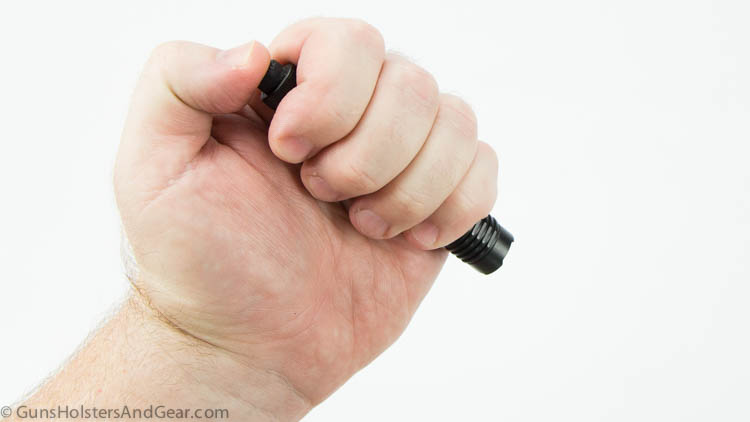
As the name suggests, the flashlight is powered by a single AAA-type battery. Streamlight designed this light to run on both alkaline and lithium batteries. While I suppose any alkaline-powered flashlight can benefit from lithium power cells, this one is clearly marketed to be optimized for them. Run times are listed for both kinds of batteries on all of the flashlight’s literature.
Streamlight rates the light at 70 lumens using either kind of battery. With the alkaline, the runtime is listed as 30 minutes. With a lithium battery, the runtime is drawn out to 2 hours and 15 minutes. Since the company specifically mentions the lithium battery, I ran tests with both lithium and alkaline. Details on those are below.
In addition to the high output mode, the light has a low and strobe mode. These modes extend the battery life and offer more flexibility in the light’s use.
Generally, I like having the low mode available. When working on something up close, 70 lumens can be a bit overwhelming. Knocking that back to 5 lumens on the low mode allows me to work on more things without draining the battery too much.
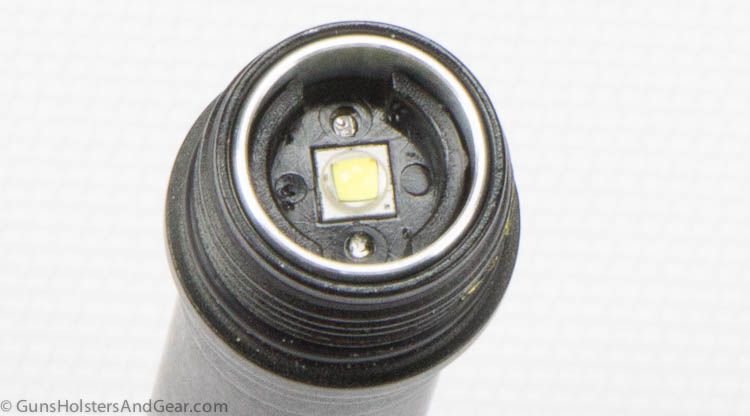
There is a bit of debate on the usefulness of the strobe mode. I would venture to say that for the average person, the strobe mode is not needed. If, however, you’ve received specialized training on low light tactics, a strobe mode can be useful.
All of the lights in the ProTac line have the Streamlight Tap-Ten programmable switch. This allows you to set up the light how you want it. If you only want high/off, no problem – you can set it up for this. If you want other options like the low and strobe modes, you can program the switch to work with those modes as well.
I’ve used other ProTac models with this style switch during high-stress incidents as a uniformed police officer. I always found the modes easy to work with, and the ProTac 1AAA seems to operate the same way. In my testing of this light, I found no problems in moving between modes or programming the switch.
The switch is in the tail cap. It is very pronounced and stands tall. It is easy to access, and I suspected it would be easy to accidentally activate. Surprisingly, this did not appear to be a problem for me. You might have a different experience.
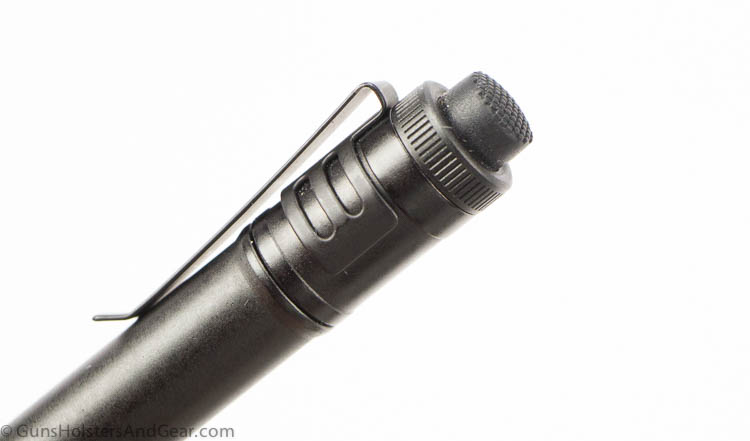
Streamlight uses a glass lens. The body is sealed with rubber gaskets to provide waterproofing. The aluminum body is black anodized; it feels and looks good out of the package. In normal, day-to-day wear, the finish held up extremely well. Read through the impact testing to see how well it withstands repeatedly hitting concrete.
The ProTac 1AAA comes with black nylon pouch and a single AAA alkaline battery. The suggested retail price is $48, though the actual street price is generally around $30.
Manufacturer Specifications
Here are the specifications for the original and updated 1AAA flashlights. As you can see, the two lights are identical from the size, weight and durability viewpoints:
| Original 1AAA | Updated 1AAA | |
| Length | 3.9″ | 3.9″ |
| Weight (w/ battery) | 1.3 oz | 1.3 oz |
| Body Diameter | 0.6″ | 0.6″ |
| Head Diameter | 0.7″ | 0.7″ |
| Impact Resistance | 1 meter | 1 meter |
| Water Resistance | IPX7 (1 meter for 30 minutes) | IPX7 (1 meter for 30 minutes) |
Light Output
The following table shows the light output of the 1AAA as reported by Streamlight using both standard alkaline and lithium batteries. As you can see, there are differences between the original and updated flashlights.
| Original 1AAA | Updated 1AAA | |
| Total Light Output | 70 lumens | 115 lumens |
| Peak Beam Intensity | 550 candelas | 890 candelas |
| Beam Distance | 47 meters | 60 meters |
| Runtime, Alkaline Battery | 0.5 hours | 1.75 hours |
| Runtime, Lithium Battery | 2.25 hours | 2.25 hours |
Improved efficiencies are to be expected when flashlights are updated. However, something that stuck out to me was the incredible jump up in runtime for alkaline batteries. Here’s how the company is able to make that claim:
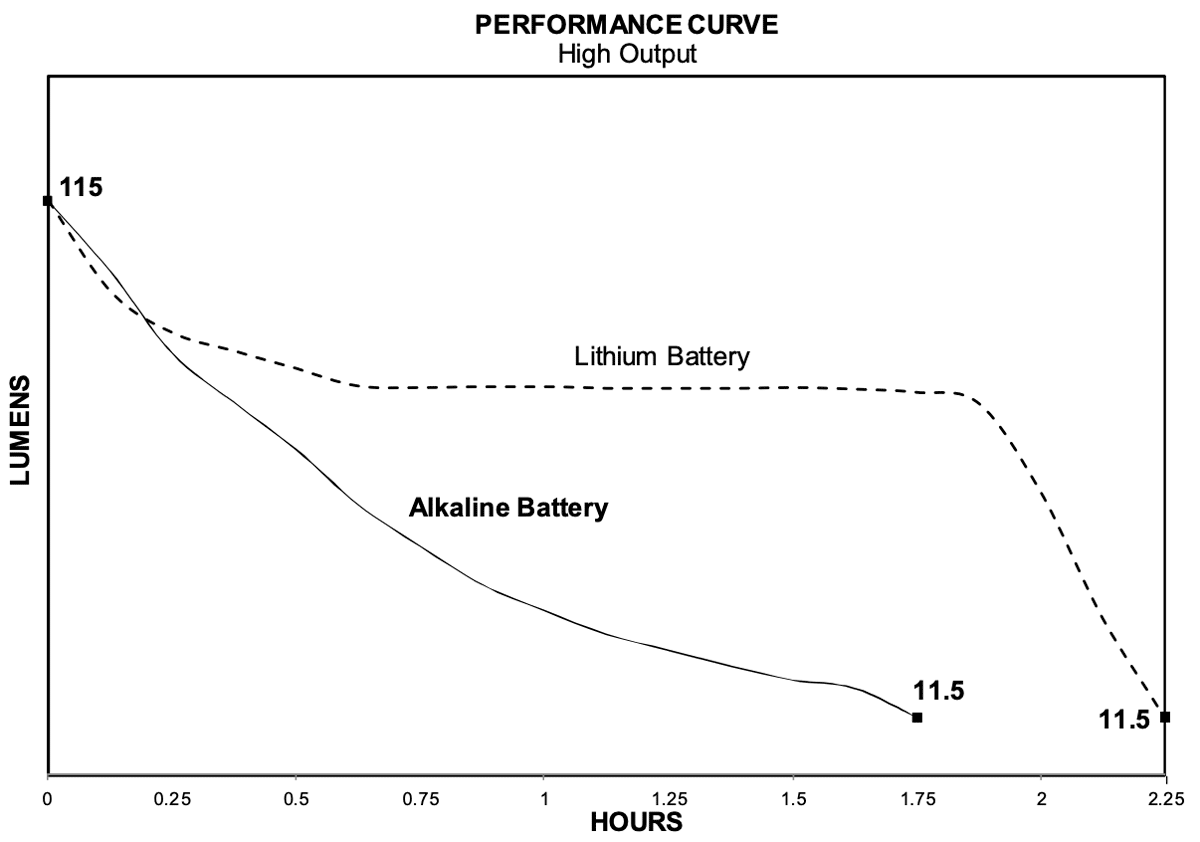
Continue on to the testing section below to see how the flashlight performed in my own testing regimen.
Testing
Streamlight adheres to the voluntary ANSI/NEMA FL-1 flashlight standards. These voluntary standards require manufacturers to test and report information in a certain way so as to give consumers better comparison information when shopping.
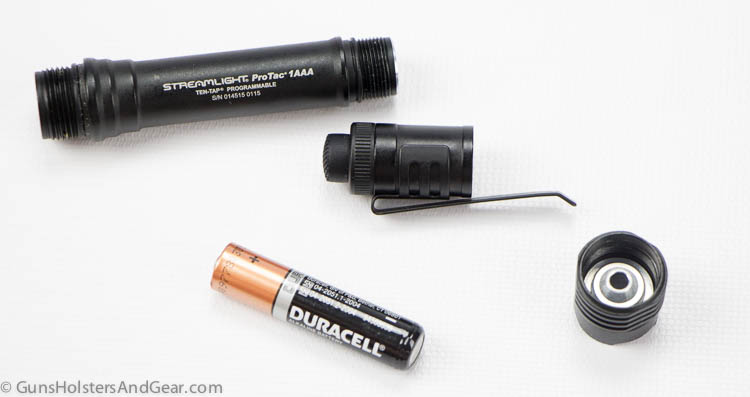
Like any standards, unscrupulous companies can tweak lights to work within the rules to paint a picture that is not necessarily an accurate depiction of the product’s performance. Therefore, I have come up with certain testing protocols that I now use to evaluate flashlights. I believe my testing protocol can be a valuable comparison tool for consumers.
For my evaluations, I measure light output over time, heat generation, impact resistance and water resistance. Additionally, I provide you with photos of the light’s beam and spill. Let’s take these individually.
Output Over Time
Using my illuminating sphere, I can measure through the lens light output over time. The numbers are relative and are not directly comparable to the lumen and candela output ratings offered by Streamlight. The data I capture gives a good indication of the visible light output over time. More information can be had on this on my flashlight reviews page.
Since Streamlight lists run times for both alkaline and lithium batteries, I tested the ProTac 1AAA with both types as well.
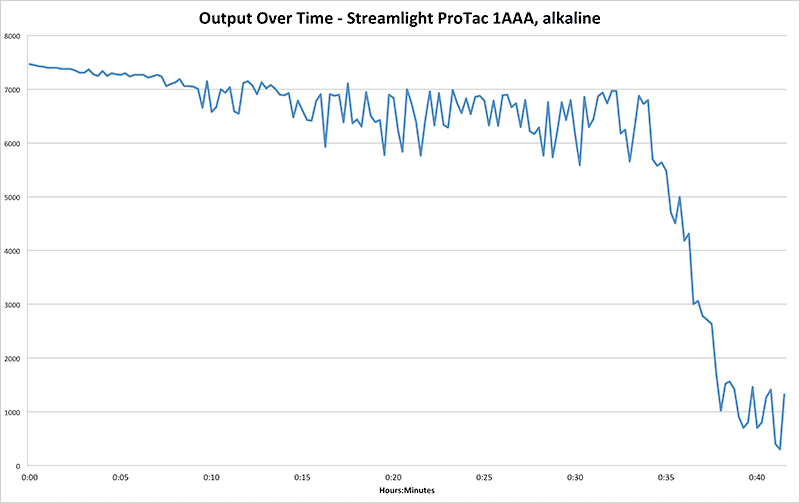
The above chart shows the visible output of the flashlight through the lens over time when using a fresh Duracell Coppertop AAA battery. Data was captured at 15 second intervals.
As should be obvious, there is variation in output in the moment-to-moment data. However, the overall output through 30 minutes averaged well above 6000 lux. Output stayed at or above 50% of the initial peak measurement through the 36 minute mark. Actual performance was better than the manufacturer’s claim of 30 minutes to a 10% output.
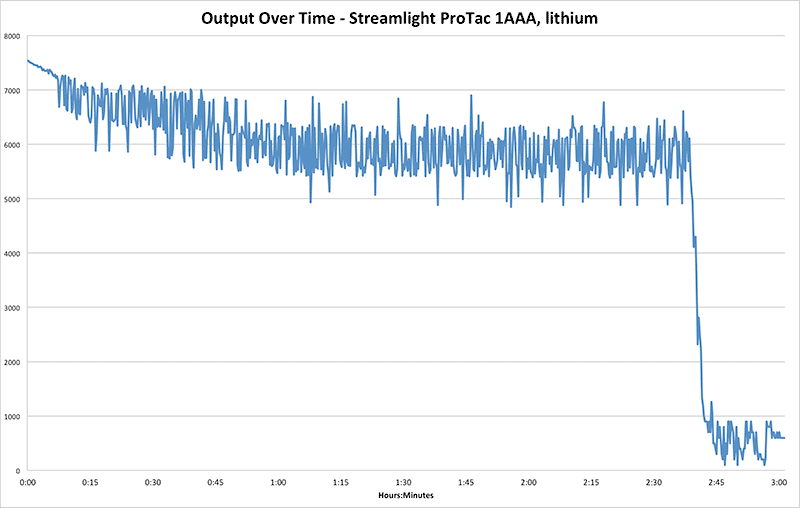
For the second output test, I used a fresh Energizer Ultimate Lithium AAA battery. After an initial drop from the peak output, the Streamlight ProTac 1AAA maintained a relatively high output through about the 2 hour 38 minute mark. At that point, visible output dropped quickly.
The flashlight maintained at least 50% of its initial output for 2 hours and 40 minutes, which is well beyond the stated 2 hours 15 minutes of runtime to a 10% output level stated by Streamlight.
Obviously, lithium and alkaline batteries are significantly different in a number of ways. In addition to providing longer run times, lithium batteries offer excellent storage life.
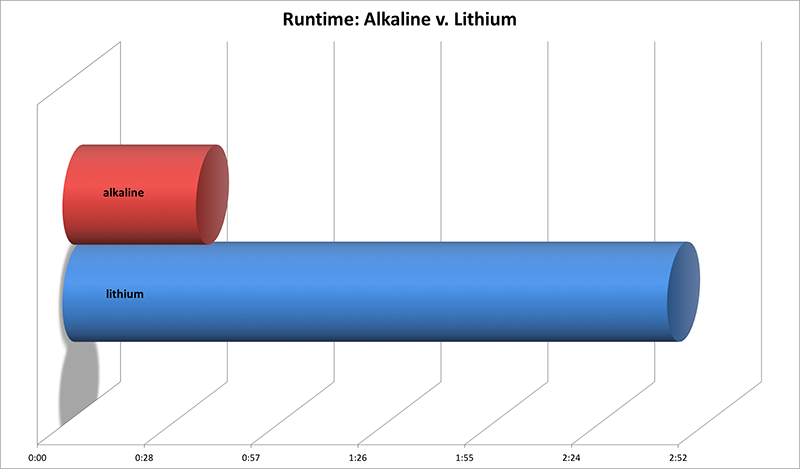
The above chart shows the 50% output runtime for both kinds of batteries. While alkaline are cheaper, the lithium batteries can be a much better value. In this case, the lithium AAA battery provided more than 4x the run time, and can be stored for long periods of time without suffering significant power loss.
Heat Generation
All lights generate heat. The more powerful the light, the more heat it will likely generate. Some flashlights do a good job of mitigating heat generation through the use of higher-efficiency parts and heat sinks. Even so, some lights can get too hot to hold.
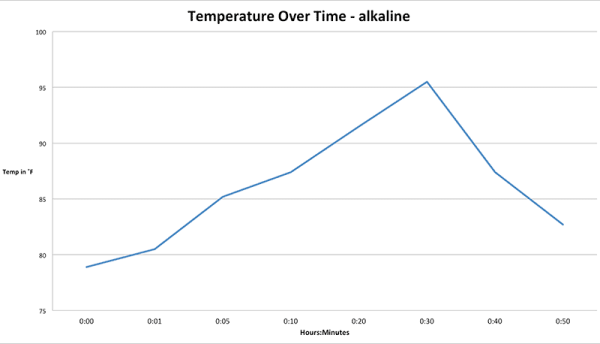
Fortunately, the ProTac 1AAA is not a hot running light. With an alkaline battery, the flashlight peaked at 95.5° F, which was just enough to register as slightly warm in the hand.
The longer-running lithium battery did drive the temperature up, but only slightly. I measured a peak of 96.8° F, roughly 1° warmer. All temperatures were measured with an infrared thermometer.
Visual Comparison
All the charts in the world cannot replace actually seeing how the 1AAA throws light in person. While I can’t put the unit in your hands to test yourself, I can provide you with a pair of photographs to see how bright it is.


Use the slider above to move between the photos on the left and right. The photo on the left is the control with no artificial illumination, while the image on the right is of the light on the high setting with an alkaline battery. Both photos were taken with the same camera on the same settings using a tripod.
The photo comparison below is between the control photo and the light with a lithium battery. Note that the lithium battery does measure as slightly brighter on the test equipment, but does not appear very much brighter (if at all) in application. I think the lithium’s biggest benefit is the increased runtime.


By way of comparison, consider the 1AAA (with an alkaline battery) vs. Streamlight’s slightly older ProTac 1AA light below. The 1AA is on the left and the 1AAA is on the right.


The 1AA does appear brighter than the 1AAA, but still not bad for the tiny flashlight.
Drop Test
Streamlight states the ProTac 1AAA is impact resistant to 1 meter. The ANSI/NEMA FL-1 standards specifies how that test is to be done. For my own recreation that approximates the FL-1 testing, I dropped the ProTac 1AAA six times from a height of 1 meter onto a concrete sidewalk: four on the sides, once on the head and once on the tail/switch assembly.
To ensure the drops impact both the head and the tail, I use a length of PVC pipe. I believe that ensuring the flashlight strikes the concrete head (and tail) on negates the velocity loss of any drag that it might develop from striking the side of the pipe.
In the above video, you can see that the flashlight passed the test not just once, but twice. I’m certainly comfortable with how well it resists standard drops.
After 12 drops onto hard concrete, the flashlight had no cracks or other significant damage. The only blemishes were on the leading edge of the flashlight head, and those were minor. The finish seems to be very good, and held up better than some of the other flashlights I have tested.
Water Resistance
For water resistance, Streamlight states the flashlight is waterproof to 1 meter for 30 minutes. For my testing, I attached the light to a 1 meter length of paracord and dropped it into my saltwater pool for 30 minutes. After 30 minutes, I pulled the light out and checked it for water intrusion.
The ProTac 1AAA passed this test with perfect marks. There was no visible penetration into any portion of the flashlight. Additionally, the light worked properly when pulled out of the pool. Checking it again several hours after the immersion showed no sign of damage or impaired function.
Since the water test, I’ve carried the flashlight for several days as my EDC light. I’ve experienced no problems with it at all.
Final Thoughts
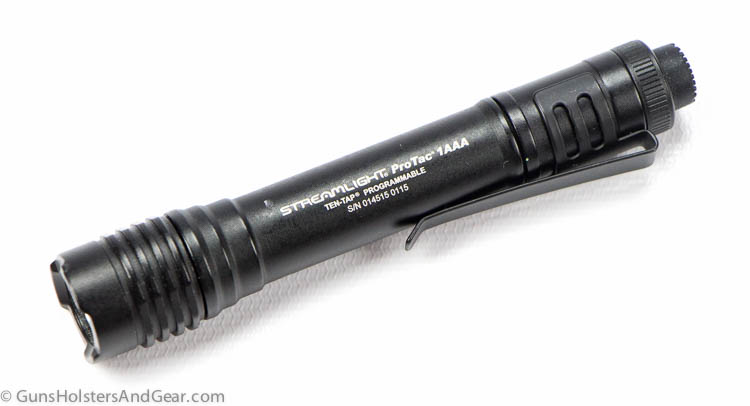
The ProTac 1AAA is a solid flashlight for everyday use. If your intent is to carry it as a self-defense flashlight, it is both reliable and compact enough to be carried everywhere.
Larger lights can be carried with certain dress, but this light can be carried with all clothing styles and during all activities. If rule one of a gunfight is “have a gun,” rule two could be “know what you’re shooting.” This light will always be there so you can follow rule 2.
I recommend this light to anyone needing an EDC flashlight. It has a great runtime, especially with a single lithium AAA battery, and is tough enough to put up with daily use.
The suggested retail price for this flashlight is $48. However, the actual “street” pricing is generally in the neighborhood of $30. I find this to be a very reasonable price. Click here to pick one of these up on Amazon.
Alternatives
If the ProTac 1AAA doesn’t tickle your fancy, there are plenty of other flashlights on the market that might. I have previously tested the ProTac 1AA and ProTac 2AAA and found them to be solid performers. For something a bit bigger and massively brighter, the ProTac HL is still one of my favorites, though it has been supplanted by the SureFire G2X. All of these lights are recommended, though each has its strengths and weaknesses.
Last Update: August 21, 2021
Disclaimer
As with all of my articles, I want you to know of any potential biases that may have affected this review. First, you – the reader – are my customer. If I am ever on the fence about a recommendation, I err on the side of caution. I want to provide you with the best information possible to make good buying decisions.
Second, at the time of this review, Streamlight is not a sponsor or advertiser of this or any website I own. Nor am I in any discussions with them to be one.
Third, the flashlight was provided to me by Streamlight for the specific purpose of testing and writing a review. After testing this flashlight, I purchased another for my ongoing use:
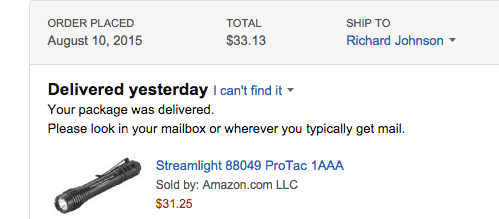
GunsHolstersAndGear.com is a for-profit website. I do not charge readers a dime to access the information I provide.
Some of the links on this page and site are affiliate links to companies like Amazon and Palmetto State Armory. These links take you to the products mentioned in the article. Should you decide to purchase something from one of those companies, I make a small commission.
The links do not change your purchase price. I do not get to see what any individual purchases.
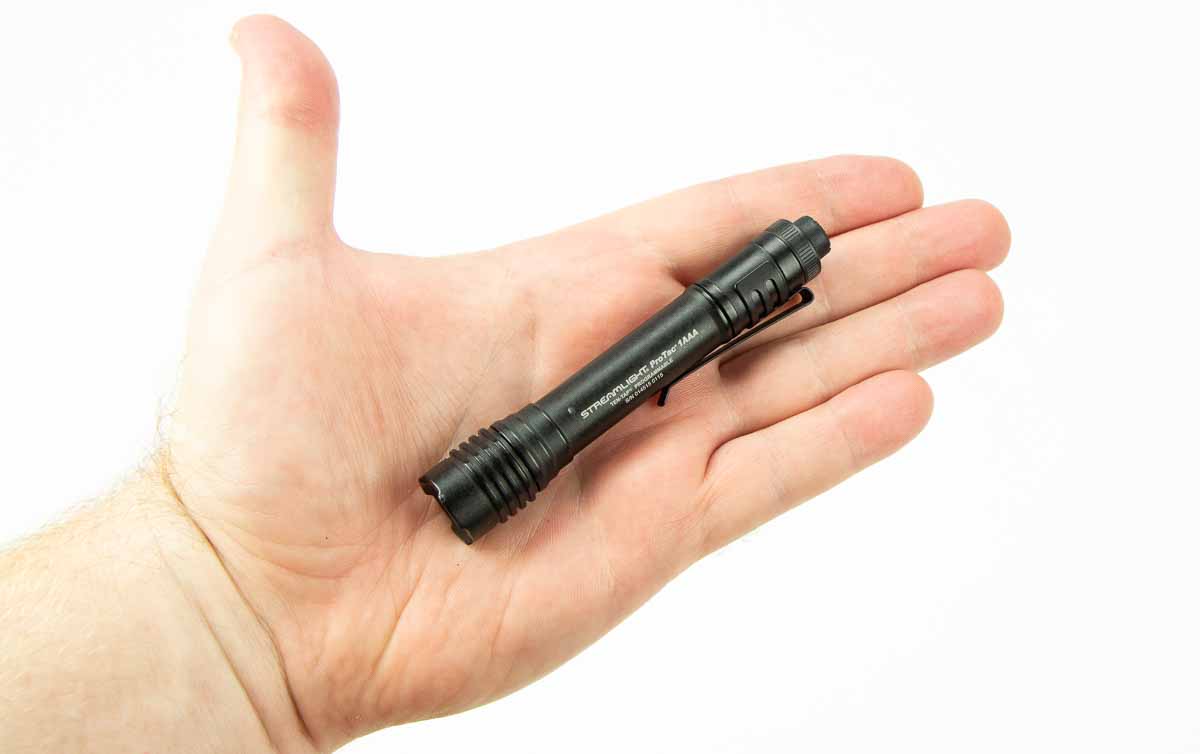
4 replies on “Streamlight ProTac 1AAA Review”
Hello from Europe 🙂
After reading your fair and excellent review of the FK BRNO Field Pistol, I happened to stumble upon this flashlight page. Having by now multiple personal experiences (unfortunately) in case of unwanted contact while using a tactical flashlight I do consider them as awesome self-defence items permitting you to avoid physical interaction with your opponents (one of them being an entire group I took on on my own with a flashlight that I changed after this interaction occurred understanding the benefits of a tactical flashlight and what characteristics I wish it had that night that were missing).
Although I conducted a hasty market research I ended up with the Olight M23 Javelot that I bought on Christmas 2017 and since had two other encounters I wish I didn’t have but fortunately all the confidence in hand to overcome both of these threats (which absolutely was not the case with my first flashlight during my confrontation with the earlier mentioned group). This Olight M23 Javelot tactical flashlight I use as an EDC, although I offer everyone (my brother, sister, girlfriend, friends, etc.) the Olight M1X Striker for their EDC as I think the M23 Javelot is slightly too big and bulky for an EDC and kind of an overkill.
Btw. I use the breaching bezels as striking weapons, and the massive stainless steel bezel of the M23 Javelot would be used to crush skulls and break ribs while the type III hard anodised aluminium bezel of the M1X Striker would be used to poke at eyes and throats just as I would use a Kubotan in martial arts.
As an EDC, my Olight M23 Javelot performed FANTASTICALLY while having gone through some unintentional abuse. Being “motorically retarded”, it has fallen half a dozen times or so (take some, leave some) on hard surfaces out of my hands as well as in relatively shallow waters (about 30cm to 40cm deep / 1ft in your terms or so…) during more than 6 hours ! It still functions perfectly !
By now (affirmative, it took a while for my little head to understand this), the lanyard that came with it is attached to my light and I recommend anyone to use it. It helps for the idiots such as myself not to drop it on hard surfaces, make it fall in water but also prevents opponents from taking it from you to a certain extent and actually facilitates deployment out of my pocket in case of unpredicted emergency…
Since my experiences with these Olight products, I am convinced but am hugely interested in a thorough review on both the M23 Javelot and the M1X Striker. I surely like some features on the latter more for self defence, such as the instant stroboscope turn on possibility I do not have on the M23 Javelot… I profoundly regret that as in one of my encounters I had to use the stroboscope and although I did keep my calm and succeeded smoothly to the transition of 3 “half-clicks”, I am still a believer of gross motor skills during stressful situations not giving everyone the tact needed to go from one mode to the other flawlessly. Including myself for that matter, God bless it wasn’t the case when needed !
Nonetheless, for the same purpose I intend to acquire a Nitecore SRT7 GT (as a direct competitor to my M23 Javelot !) with the addition of one of their bezels (separate product from Nitecore…) that would offer me some striking advantages over the massive stainless steel bezel from the M23 Olight, especially that I intend to sharpen the edges of this aforementioned bezel. This is where all of a sudden I became hesitant with another Nitecore product : the TM03 with the same head diameter accepting this bezel. Unsure of which one to get now, I’ll likely end up having them both for testing in my intentions of use which are essentially :
– temporarily blind opponents
– disorient opponents (strobe mode)
– be able to inflict bodily harm upon opponents (with an adequate bezel, preferably of stainless steel but blacked out as the silver ones are shiny and might give away my location in the dark when reflecting a light source or simply amplifying the fact I have an unidentified object in my hand… I often walk around dark areas with the turned off light already in my hand to win these precious fractions of a second it would take to deploy)
– positively ID opponents to be able to report to authorities later on
– expose opponents
– illuminate areas before entering them (thus avoiding potential conflicts…)
So if reviews on both the Nitecore SRT7 GT and the Nitecore TM03 are possible as well this would be great !
I think these are the references for my intended use, though I might be wrong as I am not an expert !
Therefore I would be hugely grateful to get your advise as you obviously did your homework on the subject.
Last but not necessarily least, as a shooter I also am interested in weapon mounted lights. To me the reference there is the Surefire X300 series (or X400 if one desires the addition of a laser aiming mode). Having gone through your Streamlight reviews, I am impatient to see a Streamlight TLR-7 and TLR-8 review as well. Are Surefire X300 / X400 and the Streamlight TLR-7 / TLR-8 the standards by which all others are measured ? This is my opinion, but again : it would be awesome and I really really really would be so grateful to get your opinions on all these products as I am not an expert but just your (maybe slightly more than) average Joe.
Sincere greetings from the other side of the Atlantic !!!
Cheers 😉
Hello from Europe 🙂
After reading your fair and excellent review of the FK BRNO Field Pistol, I happened to stumble upon this flashlight page. Having by now multiple personal experiences (unfortunately) in case of unwanted contact while using a tactical flashlight I do consider them as awesome self-defence items permitting you to avoid physical interaction with your opponents (one of them being an entire group I took on on my own with a flashlight that I changed after this interaction occurred understanding the benefits of a tactical flashlight and what characteristics I wish it had that night that were missing).
Although I conducted a hasty market research I ended up with the Olight M23 Javelot that I bought on Christmas 2017 and since had two other encounters I wish I didn’t have but fortunately all the confidence in hand to overcome both of these threats (which absolutely was not the case with my first flashlight during my confrontation with the earlier mentioned group). This Olight M23 Javelot tactical flashlight I use as an EDC, although I offer everyone (my brother, sister, girlfriend, friends, etc.) the Olight M1X Striker for their EDC as I think the M23 Javelot is slightly too big and bulky for an EDC and kind of an overkill.
Btw. I use the breaching bezels as striking weapons, and the massive stainless steel bezel of the M23 Javelot would be used to crush skulls and break ribs while the type III hard anodised aluminium bezel of the M1X Striker would be used to poke at eyes and throats just as I would use a Kubotan in martial arts.
As an EDC, my Olight M23 Javelot performed FANTASTICALLY while having gone through some unintentional abuse. Being “motorically retarded”, it has fallen half a dozen times or so (take some, leave some) on hard surfaces out of my hands as well as in relatively shallow waters (about 30cm to 40cm deep / 1ft in your terms or so…) during more than 6 hours ! It still functions perfectly !
By now (affirmative, it took a while for my little head to understand this), the lanyard that came with it is attached to my light and I recommend anyone to use it. It helps for the idiots such as myself not to drop it on hard surfaces, make it fall in water but also prevents opponents from taking it from you to a certain extent and actually facilitates deployment out of my pocket in case of unpredicted emergency…
Since my experiences with these Olight products, I am convinced but am hugely interested in a thorough review on both the M23 Javelot and the M1X Striker. I surely like some features on the latter more for self defence, such as the instant stroboscope turn on possibility I do not have on the M23 Javelot… I profoundly regret that as in one of my encounters I had to use the stroboscope and although I did keep my calm and succeeded smoothly to the transition of 3 “half-clicks”, I am still a believer of gross motor skills during stressful situations not giving everyone the tact needed to go from one mode to the other flawlessly. Including myself for that matter, God bless it wasn’t the case when needed !
Nonetheless, for the same purpose I intend to acquire a Nitecore SRT7 GT (as a direct competitor to my M23 Javelot !) with the addition of one of their bezels (separate product from Nitecore…) that would offer me some striking advantages over the massive stainless steel bezel from the M23 Olight, especially that I intend to sharpen the edges of this aforementioned bezel. This is where all of a sudden I became hesitant with another Nitecore product : the TM03 with the same head diameter accepting this bezel. Unsure of which one to get now, I’ll likely end up having them both for testing in my intentions of use which are essentially :
– temporarily blind opponents
– disorient opponents (strobe mode)
– be able to inflict bodily harm upon opponents (with an adequate bezel, preferably of stainless steel but blacked out as the silver ones are shiny and might give away my location in the dark when reflecting a light source or simply amplifying the fact I have an unidentified object in my hand… I often walk around dark areas with the turned off light already in my hand to win these precious fractions of a second it would take to deploy)
– positively ID opponents to be able to report to authorities later on
– expose opponents
– illuminate areas before entering them (thus avoiding potential conflicts…)
So if reviews on both the Nitecore SRT7 GT and the Nitecore TM03 are possible as well this would be great !
I think these are the references for my intended use, though I might be wrong as I am not an expert !
Therefore I would be hugely grateful to get your advise as you obviously did your homework on the subject.
Last but not necessarily least, as a shooter I also am interested in weapon mounted lights. To me the reference there is the Surefire X300 series (or X400 if one desires the addition of a laser aiming mode). Having gone through your Streamlight reviews, I am impatient to see a Streamlight TLR-7 and TLR-8 review as well. Are Surefire X300 / X400 and the Streamlight TLR-7 / TLR-8 the standards by which all others are measured ? This is my opinion, but again : it would be awesome and I really really really would be so grateful to get your opinions on all these products as I am not an expert but just your (maybe slightly more than) average Joe.
Sincere greetings from the other side of the Atlantic !!!
Cheers 😉
Very helpful reviews. Thank you! Have you seen any of the L.A. Police Gear branded flashlights? I am a huge fan of the Operator L2. I prefer it to my Streamlight ProTac HL. I also like their Operator L1, but not as much as the L2. I’d love to see you put the Operator L2 through your battery of tests and see how it performs.
https://uploads.disquscdn.com/images/20420d13beee37bdea4260f34632c716e96786a1380ae669b6e014355ab8434f.jpg HI David,
Thanks for taking the time to read the article and posting your feedback – I really appreciate it.
I haven’t had any of the LA Police Gear lights in my hands yet. I’ve got a couple of SureFire and Olight flashlights I’m working on now. However, I’ll put the LAPG lights on my list and see if I can’t work them in soon. I’ve purchased other things from that company, and they’ve always treated me right. So, I look forward to giving their lights a go.
I will say this about the L2 – the company lists it as being tested to the FL 1 standard. Yet, they list it as being impact resistant to 1.5 meters. The FL 1 standard requires the impact resistance rating to be rounded down to the largest whole number and that number be used in the advertising. So, the L2 ~should~ be advertised as a 1m impact resistance if they were adhering to the standard they claim. So, that does make me wonder.
Thanks again for posting and I hope to tackle the LAPG lights for you in the near future.
-Richard